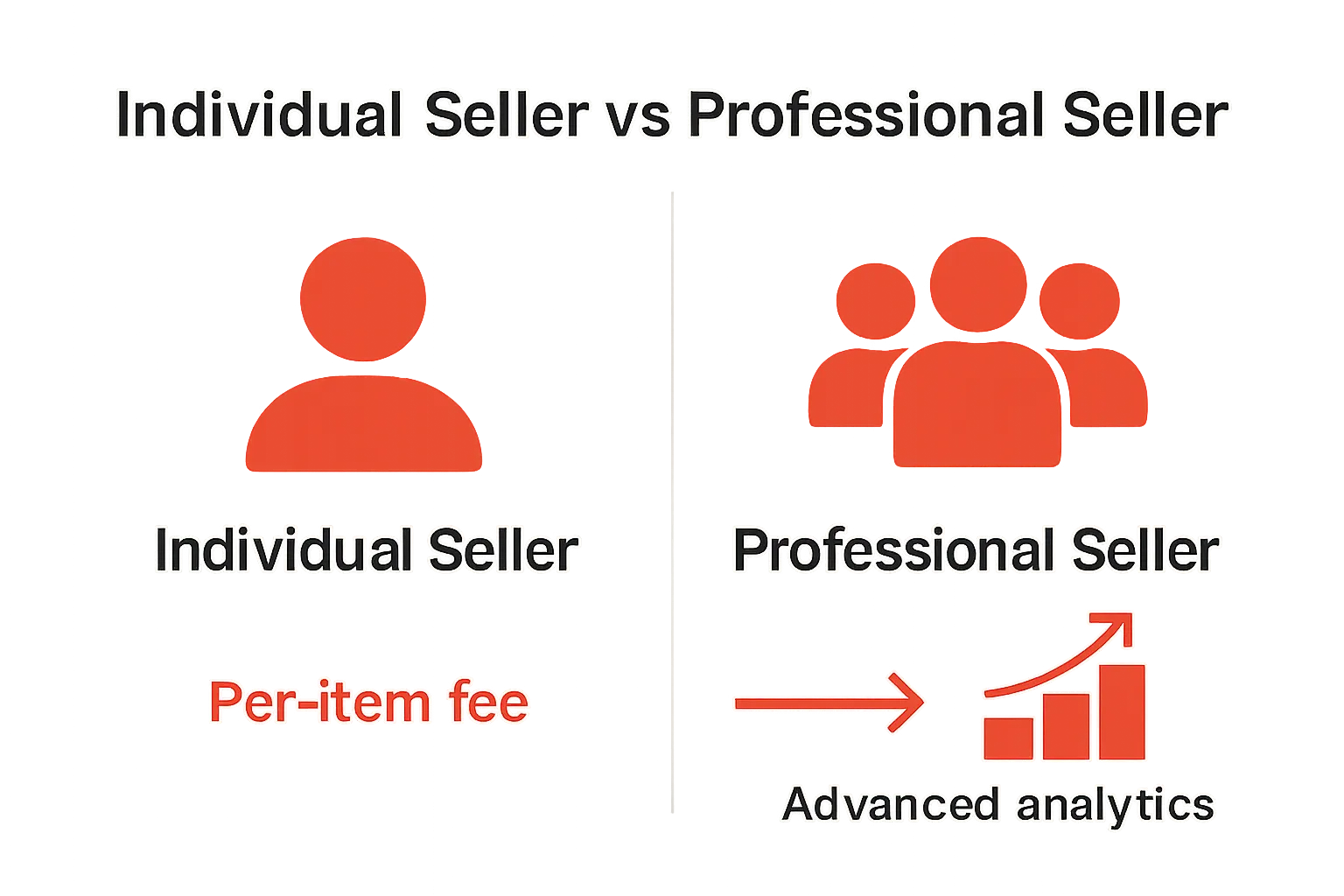
What is Seller Central? Understanding Its Importance
Posted on
Amazon Seller Central is the command center behind billions of dollars in online sales each year and offers every merchant access to professional-grade tools once reserved for big brands. Most people expect it to be just a place for posting products and tracking orders, but that is only the surface. The real surprise is that Seller Central lets small businesses reach more than 300 million active customers worldwide and gives them data and controls that can completely transform how they sell online.
Table of Contents
- Defining Seller Central: A Marketplace For Sellers
- The Importance Of Seller Central In Ecommerce
- How Seller Central Works: Key Features And Functions
- Understanding Seller Central Fees And Costs
- Navigating The Seller Central Dashboard For Success
Quick Summary
| Takeaway | Explanation |
|---|---|
| Seller Central is essential for online sellers | It allows businesses to manage their online operations effectively within Amazon’s marketplace. |
| Utilize real-time analytics for better decisions | Comprehensive metrics help sellers track performance and make informed adjustments to their strategies. |
| Streamline product listing and inventory management | Seller Central simplifies managing stock levels and product variations, enhancing operational efficiency. |
| Understand the fee structure for profitability | Knowing about account types and associated costs aids sellers in developing accurate pricing strategies. |
| Leverage advanced dashboard features for growth | The dashboard integrates critical data, enabling sellers to quickly assess and optimize their marketplace performance. |
Defining Seller Central: A Marketplace for Sellers
Seller Central is Amazon’s comprehensive web platform designed specifically for online merchants and brands looking to sell products directly to consumers through the Amazon marketplace. According to Amazon’s official documentation, this interface serves as a centralized management system where sellers can control virtually every aspect of their online selling experience.
Understanding the Core Functionality
At its foundation, Seller Central provides merchants with an integrated dashboard that enables complete control over product listings, inventory management, pricing strategies, order processing, and customer interactions. Sellers gain access to powerful tools that transform how they approach online retail, including:
- Real-time inventory tracking
- Dynamic pricing adjustments
- Comprehensive sales performance analytics
- Customer communication management
The platform distinguishes itself by offering granular control that goes beyond simple product uploading. Merchants can monitor sales metrics, adjust pricing in real time, respond to customer inquiries, and track shipping and fulfillment processes all from a single interface.
Strategic Importance for Online Sellers
Seller Central represents more than just a technical platform. It is a strategic gateway for businesses seeking to expand their online presence. By providing detailed insights and robust management tools, the platform enables sellers to make data-driven decisions about their product offerings. Read more about advanced marketplace strategies on our guide to marketplace management.
The ecosystem allows both small independent sellers and larger brands to compete on a level playing field, offering tools that previously were accessible only to enterprise-level organizations. From inventory synchronization to performance tracking, Seller Central democratizes online selling by providing sophisticated technological infrastructure to businesses of all sizes.
The Importance of Seller Central in eCommerce
Seller Central represents a transformative platform that fundamentally reshapes how businesses engage with online marketplaces. According to Amazon’s marketplace resources, the platform lowers traditional barriers for small and medium enterprises seeking digital market entry, offering unprecedented access to global consumer networks.
Expanding Market Reach and Accessibility
The digital commerce landscape demands sophisticated tools that empower sellers to compete effectively. Seller Central provides merchants with strategic advantages that extend far beyond basic product listing capabilities. By democratizing advanced selling technologies, the platform enables businesses of all sizes to access professional-grade eCommerce infrastructure.
Key market expansion benefits include:
- Instant global marketplace access
- Sophisticated inventory management systems
- Advanced sales analytics and reporting
- Integrated customer communication channels
- Automated pricing optimization tools
These features transform Seller Central from a simple listing platform into a comprehensive business growth ecosystem.
Sellers can now leverage enterprise-level technologies without requiring significant upfront technological investments.
Strategic Business Intelligence and Performance Optimization
Beyond marketplace access, Seller Central serves as a critical business intelligence hub. The platform generates comprehensive performance metrics that allow sellers to make data-driven decisions. Explore our advanced marketplace management strategies to understand how sophisticated analytics can drive business growth.
By providing granular insights into sales trends, customer behaviors, and competitive landscapes, Seller Central enables merchants to continuously refine their online selling strategies. This dynamic approach ensures businesses remain agile and responsive in an increasingly complex digital marketplace.
How Seller Central Works: Key Features and Functions
Seller Central functions as a comprehensive digital management platform that empowers online merchants with sophisticated tools for marketplace success. According to Amazon’s official platform documentation, the system provides sellers with an integrated suite of features designed to streamline every aspect of online selling.
Product Listing and Inventory Management
Effective product presentation and inventory control form the foundation of successful online selling. Seller Central enables merchants to create detailed product listings, upload high-quality images, set competitive pricing, and maintain real-time inventory tracking. Sellers can manage multiple product variations, track stock levels, and receive automatic alerts when inventory runs low.
Key inventory management capabilities include:
- Automated stock level synchronization
- Multi-channel inventory tracking
- Pricing adjustment tools
- Product variation management
- Bulk listing upload options
The platform transforms complex inventory management into a streamlined, user-friendly process that allows sellers to focus on growth strategies rather than administrative tasks.

Performance Tracking and Analytics
Beyond basic listing tools, Seller Central provides robust performance analytics that offer deep insights into business operations. Dive into our comprehensive guide on maximizing marketplace performance to understand how data-driven decisions can transform your online selling approach.
Merchants gain access to comprehensive dashboards displaying critical metrics such as sales volume, conversion rates, customer feedback, and overall account health. These insights enable sellers to make strategic adjustments, identify potential improvements, and maintain a competitive edge in the dynamic online marketplace.
Understanding Seller Central Fees and Costs
Navigating the financial landscape of online selling requires a comprehensive understanding of platform fees and associated costs. According to Amazon’s official pricing information, the fee structure is designed to accommodate different seller sizes and business models, providing flexibility while ensuring transparent cost management.
Seller Account Fee Structures
Amazon offers two primary seller account types, each with distinct fee considerations. Individual sellers pay per-item fees without a monthly subscription, while Professional sellers invest in a monthly subscription that unlocks advanced selling features. The cost-benefit analysis depends on sales volume and specific business requirements.
Below is a comparison table summarizing the main differences between Individual and Professional Amazon Seller Central accounts to help sellers determine which best fits their needs.
| Account Type | Monthly Subscription Fee | Per-Item Fee | Advanced Selling Features | Best For |
|---|---|---|---|---|
| Individual | None | Yes (per item sold) | Limited | Low-volume or casual sellers |
| Professional | Yes (monthly fee applies) | No (per item fee) | Full access | Growing businesses, high-volume |

Key fee components include:
- Monthly subscription fees
- Per-item transaction charges
- Referral fees based on product category
- Potential fulfillment and storage expenses
- Optional advertising and promotional costs
Understanding these fee layers helps sellers predict their true operational expenses and develop accurate pricing strategies that maintain profitability.
Calculating Total Selling Costs
Beyond basic platform fees, sellers must consider additional expenses that impact overall financial performance. Learn more about maximizing revenue through strategic cost management to optimize your marketplace strategy.
The total cost of selling encompasses more than just marketplace fees. Sellers must factor in product acquisition costs, shipping expenses, packaging materials, and potential return processing fees. Sophisticated sellers leverage Seller Central’s detailed financial reporting to track these nuanced expenses and continually refine their business models.
Navigating the Seller Central Dashboard for Success
The Seller Central dashboard represents the nerve center of an online seller’s marketplace operations, transforming complex data into actionable insights. According to Amazon’s official platform documentation, the dashboard provides comprehensive performance metrics that enable strategic decision making.
Understanding Dashboard Core Components
Seller Central’s dashboard is meticulously designed to offer sellers an intuitive interface for monitoring critical business metrics. The platform aggregates data from multiple sources, presenting information through customizable widgets and real-time performance indicators that track everything from sales volume to customer satisfaction.
Key dashboard elements include:
The table below highlights key Seller Central dashboard components and the primary insights each provides to better understand how they support efficient marketplace management.
| Dashboard Component | Primary Insight Provided | Example Use Case |
|---|---|---|
| Sales Performance Graphs | Tracks sales trends and volume | Monitor daily/weekly revenue changes |
| Inventory Status Updates | Displays current stock levels | Identify low stock and restock needs |
| Customer Feedback Summaries | Shows reviews and satisfaction metrics | Track customer experience and concerns |
| Order Processing Metrics | Monitors order flow and fulfillment status | Spot order delays and resolve issues |
| Advertising Performance | Presents ad campaign effectiveness | Optimize marketing spend and ROI |
- Sales performance graphs
- Inventory status updates
- Customer feedback summaries
- Order processing metrics
- Advertising campaign performance
These components work synergistically to provide sellers with a holistic view of their marketplace performance, allowing for rapid strategic adjustments and informed business planning.
Leveraging Advanced Analytics for Business Growth
Explore our comprehensive guide on maximizing marketplace advertising strategies to understand how advanced analytics can transform your online selling approach.
Sophisticated sellers utilize the dashboard’s advanced filtering and reporting tools to deep dive into performance data. By analyzing trends, identifying potential bottlenecks, and understanding customer behavior patterns, merchants can develop targeted strategies that optimize sales potential and improve overall marketplace performance.
Ready to Unlock the Full Power of Seller Central for Your Brand?
If managing Amazon Seller Central feels overwhelming and you worry about missed growth opportunities or inefficient processes, you’re not alone. Many sellers face challenges navigating complex features like product listing optimization, inventory controls, and performance analytics. Moments of uncertainty can cost you both time and revenue. This is where expert guidance and proven solutions become game changers. Discover how Reddog Group turns Seller Central challenges into growth fuel. Explore our digital and business consulting services specifically crafted for small and medium-sized brands aiming for measurable online marketplace success.

Let our team help you master the tools and strategies needed for profitable online selling. Reddog Group has already helped over 50 brands streamline operations and accelerate sales through tailored marketplace management and omnichannel solutions. Take your business further and visit Reddog Group’s website today to see how expert support can unlock sustainable growth. Ready to take control of your Seller Central journey right now? Start by exploring your options with our consulting team or check our homepage for client success stories.
Frequently Asked Questions
What is Seller Central?
Seller Central is Amazon’s online platform designed for merchants to sell products directly to consumers. It provides a centralized dashboard for managing product listings, inventory, pricing, and customer interactions.
How does Seller Central benefit online sellers?
Seller Central benefits online sellers by providing them with advanced tools for inventory management, sales analytics, and customer communication, which help them make informed decisions and expand their market reach effectively.
What are the key features of Seller Central?
Key features of Seller Central include product listing management, real-time inventory tracking, performance analytics, customer communication tools, and dynamic pricing adjustments, all designed to streamline the selling process.
How are fees structured in Seller Central?
Seller Central has two main account types: Individual and Professional. Individual sellers incur per-item fees, while Professional sellers pay a monthly subscription. Both account types have additional fees based on product category, fulfillment, and optional advertising services.
Leave a comment: